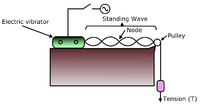Melde's experiment

Hey there! Have you ever played with a slinky before? Melde's experiment is kind of like that!
Imagine you have a really long slinky, and you hold it up in the air with one end tied to a wall. If you pull down on the slinky and then let it go, what do you think will happen?
Well, the slinky will start to wiggle and bounce up and down, right? That's because the slinky is made of metal coils, and when you pull it down and then let it go, the coils start to move back and forth.
Well, Melde's experiment is kind of like that, but instead of a slinky, we use a piece of string. We tie one end of the string to a motor, which will make the string vibrate, and the other end of the string to a piece of metal or a weight.
When we turn on the motor, the string starts to vibrate, just like the slinky bounced up and down. But something really cool happens when we change the frequency, or how fast the motor is vibrating the string.
At certain frequencies, something called a "standing wave" forms. That means the string starts to vibrate in a special way, where some parts of the string are still and other parts are moving up and down.
It's like if you were jumping on a trampoline, and your friend was standing still in the middle. You would be moving up and down, but your friend would be staying in the same spot. That's kind of what's happening with the string!
So, that's the basic idea of Melde's experiment. By changing the frequency of the motor, we can create different kinds of vibrations, including standing waves. It might sound a bit complicated, but it's actually a lot of fun to play around with!
Imagine you have a really long slinky, and you hold it up in the air with one end tied to a wall. If you pull down on the slinky and then let it go, what do you think will happen?
Well, the slinky will start to wiggle and bounce up and down, right? That's because the slinky is made of metal coils, and when you pull it down and then let it go, the coils start to move back and forth.
Well, Melde's experiment is kind of like that, but instead of a slinky, we use a piece of string. We tie one end of the string to a motor, which will make the string vibrate, and the other end of the string to a piece of metal or a weight.
When we turn on the motor, the string starts to vibrate, just like the slinky bounced up and down. But something really cool happens when we change the frequency, or how fast the motor is vibrating the string.
At certain frequencies, something called a "standing wave" forms. That means the string starts to vibrate in a special way, where some parts of the string are still and other parts are moving up and down.
It's like if you were jumping on a trampoline, and your friend was standing still in the middle. You would be moving up and down, but your friend would be staying in the same spot. That's kind of what's happening with the string!
So, that's the basic idea of Melde's experiment. By changing the frequency of the motor, we can create different kinds of vibrations, including standing waves. It might sound a bit complicated, but it's actually a lot of fun to play around with!
Related topics others have asked about:
